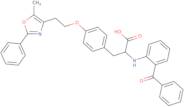Informations sur le produit
- <span class="text-smallcaps">L</span>-Tyrosine, N-(2-benzoylphenyl)-O-[2-(5-methyl-2-phenyl-4-oxazolyl)ethyl]-
- G1 262570
- Gi 262570X
- Gi-262570
- N-(2-Benzoylphenyl)-O-[2-(5-methyl-2-phenyl-4-oxazolyl)ethyl]-<span class="text-smallcaps">L</span>-tyrosine
- N-(2-Benzoylphenyl)-O-[4-[2-(5-methyl-2-phenyloxazol-4-yl)ethyl]-L-tyrosine
- N-(2-benzoylphenyl)-O-[2-(5-methyl-2-phenyl-1,3-oxazol-4-yl)ethyl]-L-tyrosine
- N-(2-Benzoylphenyl)-O-[2-(5-methyl-2-phenyl-4-oxazolyl)ethyl]-L-tyrosine
- L-Tyrosine, N-(2-benzoylphenyl)-O-[2-(5-methyl-2-phenyl-4-oxazolyl)ethyl]-
Farglitazar is a hydroxyl fatty acid ester that inhibits the enzyme fatty acid synthase, which plays an important role in the production of triglycerides. It has been shown to be active in vitro, but it has low potency and is not effective in vivo. Farglitazar is used for the treatment of metabolic disorders such as type 2 diabetes mellitus. It is believed that this drug works by inhibiting the synthesis of fatty acids from carbohydrates, thereby reducing hepatic glucose production. Farglitazar blocks the activation of granulosa cells and reduces testosterone levels in men because it inhibits phosphorylation of protein kinase B (PKB). The binding sites for farglitazar are steric interactions with collagen and hydrogen bond formation with water molecules.





